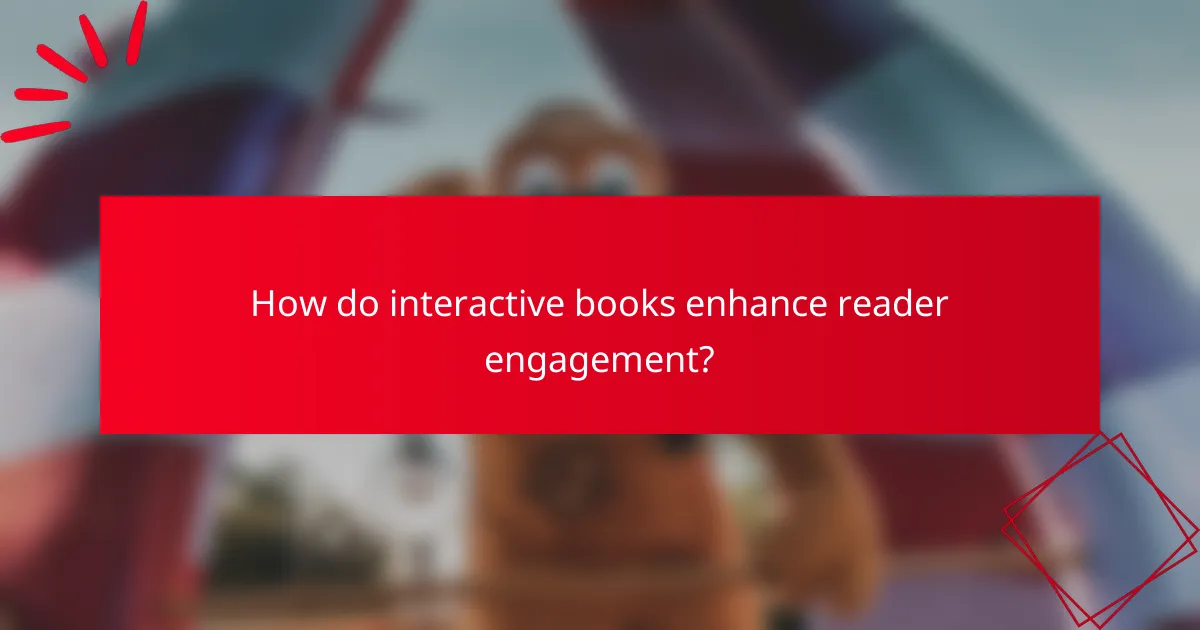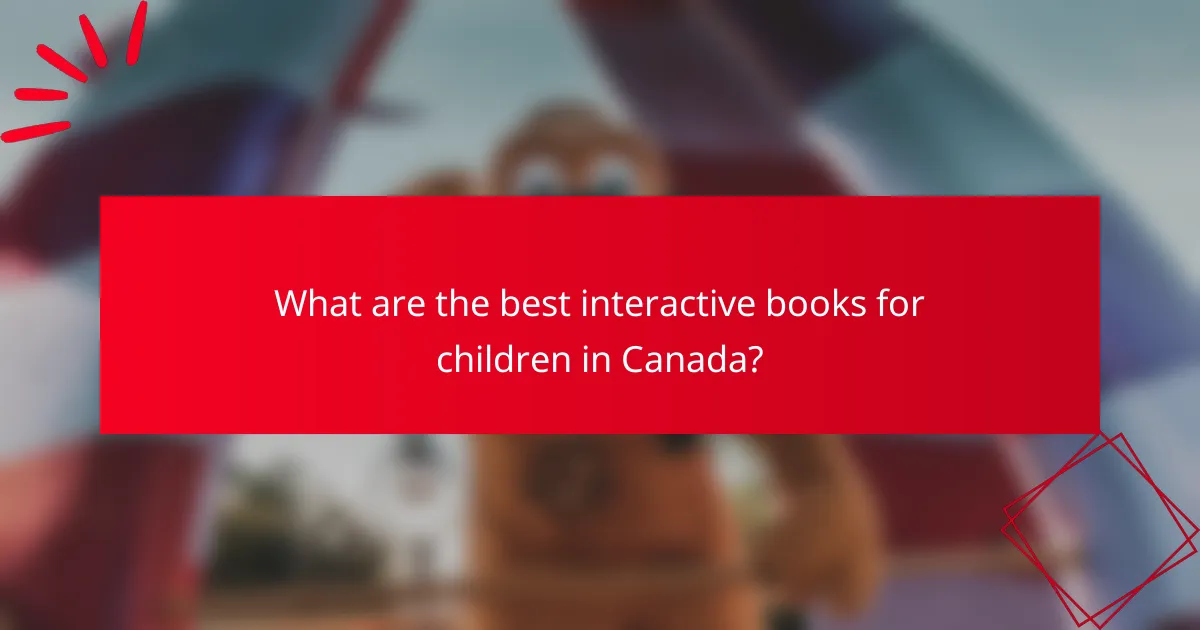Interactive books significantly enhance reader engagement by incorporating features like pop-ups and flaps that invite active participation. These dynamic elements not only entertain but also promote cognitive skills and creativity, making them ideal for young readers. When selecting an interactive book, it’s essential to consider age appropriateness and educational value to ensure a meaningful reading experience.

How do interactive books enhance reader engagement?
Interactive books enhance reader engagement by incorporating elements that invite participation and exploration. Features like pop-ups and flaps create a dynamic reading experience, encouraging readers to interact with the content actively.
Increased interactivity through pop-ups
Pop-ups in interactive books provide readers with surprising visual elements that can enhance understanding and enjoyment. These features often include illustrations or text that emerge when a page is turned or a specific area is pressed, making the reading experience more immersive.
For example, a pop-up might reveal a character in a story or an important object, prompting readers to engage with the narrative on a deeper level. This type of interactivity can be particularly effective for younger audiences, as it captures their attention and fosters curiosity.
Flaps that reveal hidden content
Flaps in interactive books serve as a mechanism for uncovering hidden information, adding layers to the storytelling. When a flap is lifted, it can disclose additional text, illustrations, or even interactive elements that enrich the narrative.
These hidden features can serve educational purposes, such as providing facts related to a story or offering insights into characters’ thoughts. This element of surprise keeps readers engaged and encourages them to explore the book more thoroughly.
Engaging storytelling techniques
Interactive books often employ storytelling techniques that leverage their unique features to create a captivating experience. Techniques such as branching narratives, where readers make choices that affect the story’s outcome, can significantly increase engagement.
Additionally, the use of vibrant illustrations and interactive elements can help convey emotions and themes more effectively. By combining traditional storytelling with interactive components, these books can appeal to a wider audience and enhance the overall reading experience.

What are the best interactive books for children in Canada?
The best interactive books for children in Canada engage young readers through tactile elements like pop-ups and flaps, enhancing their reading experience. These books not only entertain but also promote cognitive skills and creativity, making them popular choices for parents and educators alike.
Press Here by Hervé Tullet
“Press Here” is a unique interactive book that invites children to engage directly with its pages. Readers are prompted to press dots, shake the book, and tilt it, creating a playful experience that encourages participation and imagination.
This book is suitable for preschoolers and early readers, as it combines simple instructions with colorful illustrations. Its interactive nature fosters a sense of curiosity and exploration, making it a favorite in many Canadian households.
The Book with No Pictures by B.J. Novak
B.J. Novak’s “The Book with No Pictures” turns the traditional reading experience on its head by relying solely on text to create humor and engagement. Children are encouraged to read silly phrases and make funny sounds, which keeps them entertained and involved.
This book is ideal for children aged 4 to 8, as it promotes reading aloud and boosts confidence in young readers. Its unique format makes it a great choice for storytime sessions, especially in classrooms across Canada.
Where’s Waldo? by Martin Handford
“Where’s Waldo?” is a classic interactive book that challenges children to find Waldo hidden in detailed illustrations. This search-and-find format not only entertains but also enhances observational skills and attention to detail.
Suitable for a wide age range, from young children to adults, this book can be enjoyed individually or as a group activity. Its popularity in Canada makes it a staple in many libraries and homes, providing hours of fun and engagement.

How to choose the right interactive book?
Choosing the right interactive book involves considering factors such as age appropriateness, the level of interactivity, and educational value. These elements ensure that the book engages the reader effectively while meeting their developmental needs.
Consider age appropriateness
Age appropriateness is crucial when selecting an interactive book, as it determines whether the content and complexity are suitable for the intended reader. Books designed for younger children often feature simpler language and more basic interactive elements, while those for older kids may include more sophisticated themes and challenges.
Check the recommended age range on the book’s cover or description. For example, a book labeled for ages 3-5 will typically have larger text and fewer interactive features than one aimed at ages 8-12, which may include puzzles or complex narratives.
Evaluate the level of interactivity
The level of interactivity can vary significantly between books, impacting how engaged the reader will be. Some interactive books include flaps, pop-ups, or sound buttons, while others may offer digital elements like apps or online content. Consider what type of interaction will best capture the reader’s interest.
For instance, younger children might enjoy books with tactile elements like textures or pull-tabs, while older readers may prefer books that challenge them to think critically or solve problems through interactive activities.
Check for educational value
Assessing the educational value of an interactive book is essential to ensure it contributes positively to a child’s learning experience. Look for books that incorporate learning objectives, such as vocabulary development, critical thinking, or STEM concepts, alongside their interactive features.
Many interactive books are designed to teach specific skills or concepts, so consider those that align with the reader’s educational goals. For example, a book that combines storytelling with math puzzles can be both entertaining and instructive, making it a valuable addition to a child’s library.

What are the benefits of pop-up books?
Pop-up books offer unique benefits that enhance reader engagement and enjoyment. Their interactive elements, such as three-dimensional structures, create a captivating reading experience that can stimulate learning and creativity.
Enhanced visual appeal
Pop-up books are visually striking, drawing readers in with colorful illustrations and dynamic designs. The three-dimensional aspects make the story come alive, capturing attention more effectively than traditional flat books.
This visual stimulation can be particularly beneficial for young readers, as it helps maintain their interest and encourages them to explore the narrative further. The vibrant colors and intricate designs can also aid in comprehension and retention of the material.
Encourages tactile interaction
The interactive nature of pop-up books invites readers to touch and manipulate the elements, fostering a hands-on learning experience. This tactile interaction can enhance understanding and make reading more enjoyable.
For example, children can lift flaps or pull tabs to reveal hidden illustrations or text, making the reading process more engaging. This physical involvement can help reinforce concepts and improve memory retention.
Stimulates imagination and creativity
Pop-up books encourage imaginative thinking by presenting stories in a visually dynamic way. The surprising elements of pop-ups can inspire readers to create their own narratives or expand on the existing storylines.
By engaging with the book’s interactive features, readers can visualize scenarios and characters more vividly, enhancing their creative skills. This imaginative play is crucial for cognitive development, particularly in early childhood education.

What are the top brands for interactive books?
The leading brands for interactive books focus on engaging readers through innovative designs and features. Notable names include Chronicle Books and Little Simon, both known for their unique approaches to reader interaction.
Chronicle Books
Chronicle Books is renowned for its creative and visually appealing interactive books that often incorporate pop-ups, flaps, and other engaging elements. Their titles frequently target both children and adults, making reading a more immersive experience.
When selecting Chronicle Books, consider their diverse range of themes, from educational content to whimsical storytelling. Popular titles often include interactive features that encourage readers to explore and participate actively, enhancing comprehension and enjoyment.
Little Simon
Little Simon specializes in interactive books for younger audiences, focusing on early literacy and engagement. Their books typically feature sturdy flaps and tactile elements designed to captivate toddlers and preschoolers, fostering a love for reading from an early age.
When choosing Little Simon books, look for titles that promote interaction through simple questions or activities that encourage children to respond. This approach not only entertains but also supports developmental skills such as vocabulary building and critical thinking.


